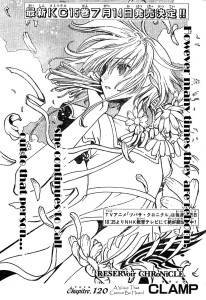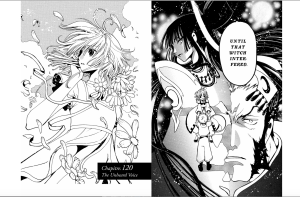I feel the need to begin this post with a disclaimer. I love ebooks. I don’t mind not having the tactile feeling of a physical book as I read. The tactile feeling of my ereader is enough for me. I have noticed differences in how I read and what I retain when reading ebooks versus physical books, and I have some preferences as to what genres I read in either. Still, I’m generally happy either way.
That being said, I’ve had a very bizarre experience reading manga in print and online. Not all manga, but one specific series. Manga, though I’m sure everyone knows this, are Japanese comics. So for me to even read them at all they must go through a pretty significant change. Not only must they be translated into another language, but Japanese characters (ex. for sound effects) are often integrated into the art, which forces the translators to choose between leaving them in, often unexplained, or replacing them with Roman letters. I’ve experienced both.
The series I had such a strange time with is Tsubasa: Reservoir Chronicle (hereby called TRC) by the manga artist group Clamp, which was published from 2003-2009. As I was reading it, I quickly became impatient with the speed at which the volumes were released. Chapters of the manga were being published serially in Japan and I had to wait months for them to be collected, translated, and delivered into my greedy hands. So, I started reading them in scanlation. Scanlations are fan-made translations, written on top of scans of the Japanese originals and posted on the internet as they are released. They are often dark and smudgy, retaining the physical look of the paper as well as distortion caused by the scanning process. The translations themselves can be awkward.

Despite this, I read buckets of scanlated manga. TRC itself I read and reread multiple times, eventually obtaining image files of the scans and cobbling together my own PDF ebooks.
Eventually, I decided I should read the legitimate, legal, licenced translations. But, when I got the books from the library the experience was disorienting. The pages were too small compared to what I had on my computer – the images weren’t distinct enough, the print was too small. The need to hold the book open wide so that the gutter wouldn’t distort the illustrations annoyed me. The paper itself was too powdery, but it smelled very nice, more gentle than other books, and gave a creamy cast to the illustrations. I’d read other manga in physical form without noticing anything. Somehow, my brain couldn’t handle switching formats with this particular series.
Recently, I started buying TRC in ebook form. That reading experience too is very different. The lines are cleaner and the whites are brighter, which is lovely. And, they come with the licenced translations. Still, one disorienting difference is that the ebooks show the page spreads, both recto and verso. Having read the manga so many times page by page, image file by image file, it’s a strange experience. I am essentially retraining my brain to read this format.

I have read three different representations of this series, and each time it has been like reading a different thing. The scanlations focused on the textual, linguistic content. That was the reason for their existence, after all. The physical and ebook forms showcase the art more. Yet, the gutters of the physical books obscure some of the image content and page transitions, whereas the flatness of the ebooks makes it almost too easy to move from page to page.
In the end, I suppose I will continue to switch between formats. Each one has its benefits and drawbacks, and each supplies a unique and valuable experience.

Hey Isabel,
I am intrigued by the way the scanlation versions of the Manga had fan translations. I appreciate that these made them more quickly available to english speaking audiences but I wonder if any fans took the translation rather liberally? Did you compare the scanlation versions to the official translations? I wonder if any fans expressed their own interpretations of the comics in their translations. If they had if would be an interesting example of reader experience with the series.
Kali
Hi Kali,
That’s a really interesting comment! I never checked translations against each other. I should!
And this is not just an issue with scanlated manga. I remember a number of years ago, the publisher Tokyopop did a licensed translation of the series Wish by Clamp. Some characters were referred to by gender-neutral pronouns in Japanese, and they decided to change these to gender-specific pronouns in the translation. While they explained their decision in the introduction, it still had a huge effect on the reading of the series and the characters.
Isabel